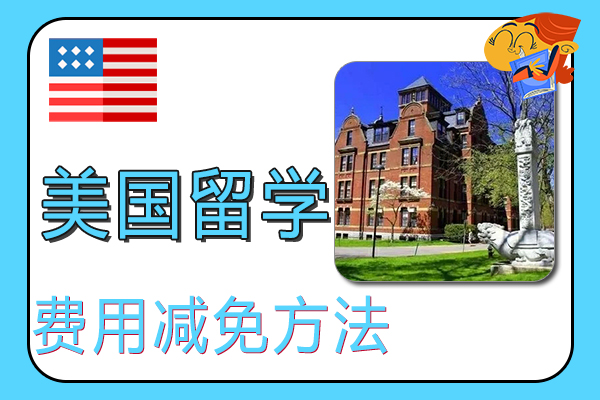The United States has a high quality of education and is one of the top countries for parents to send their children to study abroad. The following is a list of information aboutHow to reduce the cost of studying in the United StatesCost of studying in the United States, ,Cost of studying in junior high school in the United States, ,Cost of studying in Canada and the United States, ,Is studying in the United States cheap?The problem.

How to reduce the cost of studying in the United States
1. Methods for reducing the cost of studying in the United States
1. Apply for a scholarship
Scholarships are mostly available to graduate students. They are a kind of reward given to you for helping professors or participating in research projects while you are studying. They are similar to a monthly student salary. Undergraduate students basically don't have to think about this. However, if you are lucky enough to be noticed by a professor while you are an undergraduate, you may get it.
2. Strive for scholarships
There are two types of scholarships mentioned here, one is the on-campus scholarship, and the other is the foundation scholarship. The foundation scholarship is actually provided by outside the school, that is, private individuals or companies. As a student, you can apply for on-campus or off-campus scholarships. Of course, off-campus scholarships have more content and richer content than on-campus scholarships.
3. Apply for tuition fee reduction
This is also available, but this type of tuition reduction has various regulations and conditions, such as for students with disabilities or families with serious income tragedies. Of course, if you can prove that your family's financial ability cannot help you complete your studies, you can also apply for this.
4. Save or reduce accommodation on and off campus
This is a type of scholarship specially set up by American schools to reduce the cost of studying in the U.S. If you feel that you cannot afford such high accommodation fees if you live in school, and your family is in financial difficulty, you can make a request and apply to the school in this regard.
5. Obtain research and teaching assistantships
Graduate schools in the United States will set up these two types of service-based financial aid, but they are only available to students who are studying for a master's degree or higher in the United States. This requires good academic performance and a strong level of English, and further review by professors or school service agencies before you can get it.
2. Introduction to the American Study Abroad System
1. Semester system
This is the same as the academic system of domestic universities. Each academic year is divided into two semesters. Each semester has 14-20 weeks of courses. The study time is about nine months. One week will be arranged as an examination week in each semester for everyone to complete the course assessment.
With this arrangement, students will have more time to arrange their own course studies and prepare for exams. They will have sufficient time for both theoretical learning and project research. However, this will also bring the disadvantage of low efficiency and resources will not be fully utilized.
2. Quarter System
One academic year's study is divided into ten semesters. Each semester has about 9-11 weeks of courses, and also includes summer courses. The goals of each quarter will be arranged according to the four seasons, so that everyone's study will be more compact. The summer courses are elective courses, and you can report not to attend classes.
The arrangement shortens the teaching time and increases the number of semesters so that students can remain in a more active and sensitive learning stage. There will also be fewer courses per semester so that students can be more focused. However, due to the tight schedule, everyone faces greater pressure.
3. Three-semester system
This academic system is more common in European countries and has been introduced in the United States. It divides the twelve months of a year into three semesters. Students must complete the fall and winter semesters, and can take the spring and summer classes as electives. There are four admission opportunities each year, and students can apply for graduation after completing their studies.
The first semester is the fall class, which will start in late August or early September and end before Christmas; the second semester is the winter class, which starts in January and ends in October; the third semester will be divided into two small semesters, and you can choose any semester to enroll and take elective courses.
4. 4-1-4 or 4-4-1
As the name suggests, the study time of one academic year is divided into three stages, including two four-month semesters and one one-month semester. Mini semesters can be arranged between semesters or after semesters.
The ten-month semester is the formal period of professional course study. Everyone needs to complete their professional studies in school. The mini semester will arrange students to conduct study exchanges or internships outside the school.
3. Luggage items you need to prepare for studying in the United States
1. Documents
Admission letter, passport, graduation certificate, original transcript, TOEFL and GRE test score reports, I-20 form, SEVIS fee receipt, medical examination certificate, immunization and vaccination certificate, driver's license, etc. It is recommended to make a copy of important documents.
2. Important contacts and important information
Important information such as the school's international department contact number, airport pick-up information (if any), domestic emergency contact number, flight information, etc. should be written down in a notebook to avoid emergencies such as cell phone loss or temporary battery failure.
3. Banknotes and credit cards
According to customs regulations, if you carry more than 5,000 US dollars and less than 10,000 US dollars in cash, you must declare it when you pass through customs, and the process is very cumbersome. If you carry more than 10,000 US dollars, you will not be allowed to pass through customs. Therefore, it is recommended that students carry a small amount of US dollars, about 2,000 yuan, for emergency use when they first arrive in the United States. It is recommended to carry a domestic dual-currency credit card for domestic remittances to the United States, and an international bank credit card.
4. Daily necessities
Simple toiletries (toothbrush, toothpaste, facial cleanser, etc.) and travel-sized shower gel, shampoo, etc. You will be very busy in the first one or two days after landing in the United States. If you don’t bring these items and forget to buy them because you are too busy, it will be very troublesome.
A small amount of seasonal clothing and a few pieces of clothing you really like, underwear, etc. It is recommended not to bring too many clothes, because American clothes are relatively cheap and of good quality, so you can buy more when you arrive in the United States. Girls with smaller shoe sizes can bring some shoes, because it is difficult to buy shoes in the United States in size 35 or smaller.
Blankets and sheets. It is not recommended to bring pillows and quilts, which take up a lot of space. You can bring a light blanket and sheet so that you don't have to sleep too badly on the day of landing. You probably won't want to rush to IKEA as soon as you get off the plane.
A small amount of skin care products, cosmetics, men's razors, antiperspirant, etc., and a pair of plastic slippers. Skin care products and cosmetics are relatively cheap in the United States, so it is not recommended to bring a lot. Men's razors are also cheap in the United States. It is recommended to bring a pair of plastic slippers, because Americans rarely wear slippers to take a bath, so plastic slippers for bathing are more difficult to buy.
5. Electronic equipment and auxiliary tools
Conversion plugs. It is highly recommended to bring 2-3 conversion plugs, which will make your life in the United States much more convenient.
A large-capacity USB drive. You can put some important electronic files, as well as study materials and important materials in China.
A phone card with international roaming function. This phone card allows you to contact your family in time and report your safety when you get off the plane.
1-2 pairs of spare glasses. Myopic students should be aware that it is generally troublesome to get glasses in the United States, and you have to wait for at least a few days. In addition, most American frames are not suitable for Asian faces, so it is recommended that you bring two spare pairs.
Computers, cameras, cell phones and other electronic products are not recommended as they are heavy and easily damaged. Electronic products from the United States are very cheap and can be purchased in the United States.
6. Commonly used medicines
It is recommended to bring some daily and emergency medicines. For example, it is recommended to bring an appropriate amount of common medicines such as cold medicine, gastrointestinal medicine, allergy medicine, painkillers, etc. It is troublesome and expensive to buy medicine in the United States. If you have medicines you are used to, remember to bring some.
Summary of methods to reduce tuition fees for studying in the United States
After understanding the methods of reducing the cost of studying in the United States, you will also need to prepare an Internet tool to bypass the firewall and return to China when studying in the United States.For many Chinese who go to the US to study and work, they still like to watch some Chinese TV series and programs in China, and they are more accustomed to use some domestic native apps to listen to music, watch videos, play games and so on. However, due to copyright reasons, most of the popular programs are only allowed to be accessed by mainland IPs. In such a big background, theBack to China via the InternetQuickFox is a professional accelerator for returning to China, which can help overseas Chinese solve the access restriction problems encountered when browsing domestic websites and apps.














